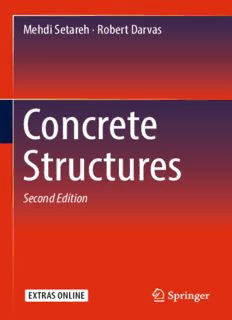
Concrete Structures PDF
Preview Concrete Structures
Mehdi Setareh · Robert Darvas Concrete Structures Second Edition Concrete Structures Mehdi Setareh • Robert Darvas Concrete Structures Second Edition MehdiSetareh RobertDarvas CollegeofArchitecture CollegeofArchitecture andUrbanStudies andUrbanPlanning VirginiaTech UniversityofMichigan Blacksburg,VA,USA AnnArbor,MI,USA Additionalmaterialtothisbookcanbedownloadedfromhttp://www.springer.com ThepreviouseditionwaspublishedbyPearsonEducation,Inc.in2006. ISBN978-3-319-24113-5 ISBN978-3-319-24115-9 (eBook) DOI10.1007/978-3-319-24115-9 LibraryofCongressControlNumber:2015954568 ©SpringerInternationalPublishingSwitzerland2017 Thisworkissubjecttocopyright.AllrightsarereservedbythePublisher,whetherthewholeorpartof the material is concerned, specifically the rights of translation, reprinting, reuse of illustrations, recitation, broadcasting, reproduction on microfilms or in any other physical way, and transmission or information storage and retrieval, electronic adaptation, computer software, or by similar or dissimilarmethodologynowknownorhereafterdeveloped. The use of general descriptive names, registered names, trademarks, service marks, etc. in this publicationdoesnotimply,evenintheabsenceofaspecificstatement,thatsuchnamesareexempt fromtherelevantprotectivelawsandregulationsandthereforefreeforgeneraluse. Thepublisher,theauthorsandtheeditorsaresafetoassumethattheadviceandinformationinthis book are believed to be true and accurate at the date of publication. Neither the publisher nor the authors or the editors give a warranty, express or implied, with respect to the material contained hereinorforanyerrorsoromissionsthatmayhavebeenmade. Printedonacid-freepaper ThisSpringerimprintispublishedbySpringerNature TheregisteredcompanyisSpringerInternationalPublishingAGSwitzerland To Roufia, Ali, and Kamran with love Mehdi To Eva with love, Robert Preface to the Second Edition Sincethepublicationofthefirstedition,therequirementsforthedesignofconcrete structures have gone through a number of changes as reflected in the American Concrete Institute, ACI 318 publication. The latest revision of the Code was published in 2014 and represents the state-of-the-art of the current knowledge in concreteandreinforcedconcretedesign.Thisrevision,ACI318-14,formsthebasis ofthesecondeditionofthistextbook. Thebookretainsthefeaturesthatmadeitwellreceivedbystudents,instructors, and practitioners alike. The popular step-by-step approach of problem solving, augmented by flowcharts and supported by numerical solutions, clearly describes the processes that need to be followed to provide safe and economical designs of reinforced concrete components. The self-experiments included at the end of the chaptershelpstudentsbetterunderstandthebehaviorofconcretestructuresthrough theconstructionandtestingofscaledmodels. To make the book more useful to students in Construction Engineering pro- grams,anewchapter(Chapter8)onformworksformonolithicconcreteconstruc- tionhasbeenadded.Thischaptercoversthefundamentalsofformworkandshoring design, and detailed step-by-step solutions of numerical problems along with mathematical formulae and tables to help students and practitioners to design these temporary structures. In addition, to provide more visual clarifications of the topics discussed in the book, a new appendix (Appendix B) is added, which includes color images of various stages of concrete construction and completed buildings. We gratefully acknowledge the support of the following individuals and orga- nizationsbyprovidingimagesthatareusedinthebook:ProfessorJackDavis,Dean of Virginia Tech College of Architecture and Urban Studies, Ms. Kathe Hooper fromtheAmericanSocietyforTestingandMaterials,Mr.CharlesJamesfromthe National Information Service for Earthquake Engineering, Ms. Angela Matthews fromtheAmericanConcreteInstitute,Ms.GwenWangfromthePortlandCement Association,andMr.DougPeters,PE,PresidentofChristmanConstructors,Inc. vii viii PrefacetotheSecondEdition Wealsoowespecialthankstothefollowingindividuals:Mr.NadirMakhlouf,a partnerofRobertDarvasAssociates,PC,forhisgreathelpinpreparingthegraphics work for Chapter 8, Mr. Xiaoyao Wang, Mr. Hasheem Halim, and Mr. Sriram Sankaranarayanan,studentsatVirginiaTechschoolsofarchitectureandengineer- ing,fortheireffortsonupdatingthebookandthesolutionsmanual. The authors would like to express their thanks to Springer International Pub- lishing AG Switzerland,inparticularMr. Michael Luby, senior publishingeditor, andMr.BrianHalm,projectcoordinatorforhelpingusbringthissecondeditionto publication. MehdiSetareh Blacksburg,VA RobertDarvas AnnArbor,MI Preface to the First Edition Theintendedaudienceofthisbookisarchitecturalengineering,undergraduatecivil engineering,buildingconstruction,andarchitecturestudents.Themanuscriptcom- plies with the provisions ofthe ACI Code 318-05.The easy tofollow style of the text makes it valuable to engineering and nonengineering students. Furthermore, educatorsandpractitionersinterestedintheanalysisanddesignofconcretestruc- turesbasedonthelatestACICodeprovisionsmayalsobenefitfromit. Chapter1coversthetopicofconcretetechnology.Itdiscussesthemostimpor- tantproperties ofthemain componentsofreinforced concrete.Thistechnology is essentialforbotharchitectureandengineeringstudents. Chapter 2 discusses the analysis and design of rectangular beams and one-way slabs,includingacompletetreatmentoftheUnifiedDesignMethodasrecommended by the ACI 318-05. Several examples demonstrate the provisions of the latest changesintheACICode.Itiswrittentobenefitarchitectureandengineeringstudents aswell.Dependingonthemainobjectivesofthecourseandclasstimeconstraints, the instructor can select the specific topics and their details to be included for the intendedaudience. Chapter 3 “Special Topics in Flexure” covers T-beams, doubly reinforced beams, and a discussion of the deflection of reinforced concrete beams and slabs. These topics aremorecomplex,butindispensable inthedesignofconcrete struc- tures. The detailed technical information presented is essential for engineering students. We recommend that only a brief discussion of each topic be used in coursesforarchitecturestudents. Chapter 4 “Shear in Reinforced Concrete Beams” covers the design of shear reinforcements in reinforced concrete beams. We consider this chapter to be important in both engineering and architecture courses. The depth of coverage maybelefttothediscretionoftheinstructor. Chapter 5 covers the analysis and design of reinforced concrete columns. It includes a complete treatment of “short” columns with small and large eccen- tricities. Because most reinforced concrete columns are short and a complete treatment of slender columns is usually only covered in advanced engineering ix
Description: